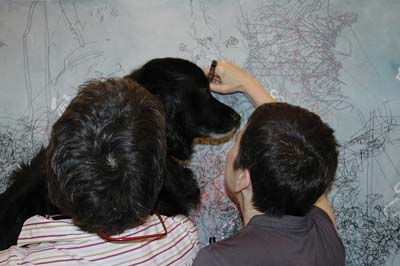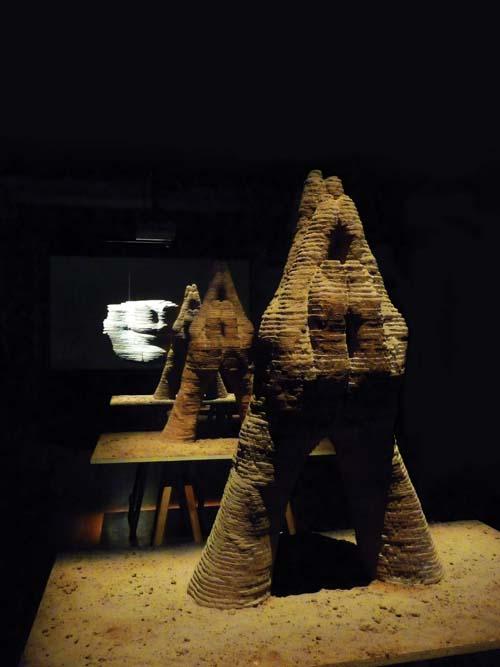
Gosia Wlodarczak's work explores relationships and shared spaces. Non-verbal conversations inscribed on linen are both her subject and text. The large, intricate drawings in this exhibition explore the potential for engagement with others, the artist as a social animal and mark-making in a shared context. Wlodarczak describes her practice as a performative drawing process in a social situation.
The artist has established strict rules of engagement for her practice. Her body and that of another must touch the linen; she then uses a range of pigment markers to explore the shared space of the encounter. Looking at the works we can see the spaces between and around bodies, shadow-forms of heads, hands and feet. The subject is at times an empty space, a vessel around which detailed drawing bustles. At times the subject is represented more traditionally. There is a physical intimacy to do with the tight proximity of the shared space which is quite different to the psychological intimacy of a portrait. Wlodarczak maps a willing donation of personal space, the encounter of two (or more) bodies on a shared stretch of linen. Nodal moments in a work such as 'Conversation' (2009) reference the interactions with (a series of) individuals. Each conversation is mapped in real time, almost like exposure against a photosensitive sheet- - a Gosia-gram. At the same time each participant is documented photographically - the individual matters. What emerges is a dance of two or more existences, responsive to the being-in-space of the other and governed in large part by the rules of social engagement. The idea of the conversation is a key concept; the artist never works in isolation but is always dependent on the interaction of another.
The conversation of an artist with the gallery visitor can so often be a monologue in an incomprehensible language. Here the encounter is reprised as an act of engagement. Wlodarczak speaks of a performative drawing process. 'The Bench' (2008) is the physical trace of encounters at the International Drawing Conference at COFA, Sydney, in October last year. 'Conversation' (2009) is inscribed with fragments of Canberra arms, and faces, even Cuzco the canine intercessory saint of Helen Maxwell’s Gallery is drawn onto the linen.
David Hansen in the 2006 essay 'Drawn in, Drawn out' has spoken about Wlodarczak’s practice being like the tip of an iceberg, its apparent lightness made possible because of a (largely hidden) substantial theoretical substructure. At its most fundamental her practice can be read as a phenomenological gesture which interrogates being in time and space. Wlodarczak speaks of the 'biological phenomenon of ‘being’’ and its relationship with sight and the body. Thus the performative act is inseparable from the act of drawing. The work provokes a range of insights both into relationships and the act of drawing. Even given the supportive environment in which much of this work is undertaken a fundamental given is the essential opacity of another’s being. We can only ever share a simple meeting of personal space. Once hung on the wall the linen reminds us that the act of drawing, like the act of seeing, is above all the performative act of a social being.












